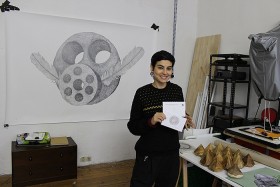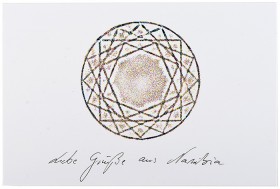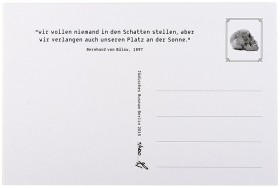With Her Art Shira Wachsmann Addresses the Nearly Forgotten Genocide of the Herero and Nama Peoples in Present-Day Namibia

The artist Shira Wachsmann in her workshop
CC-BY Saro Gorgis
The streets of Kreuzberg are soaked through with rain on this grey February day. Shira Wachsmann, a graceful young woman with short black hair, leads me into her atelier in a pre-war apartment. She doesn’t have much time. Her solo exhibition “Tribe Fire” is scheduled to open on 13 March 2016 in the gallery cubus-m in Berlin’s Schöneberg neighborhood (further information on the gallery’s website). It will remain there until 23 April. Large drawings, soon to become part of the Tribe Fire installation, hang in the atelier. “There’s still a lot to do,” the Israeli native explains.
Her most recent art project is spread across her desk: two postcards that Wachsmann designed for the Jewish Museum Berlin. She produced editions of 400 of each piece, which have been available for individual purchase since 1 April 2016 in the art vending machine of the museum’s permanent exhibition (more information on the art vending machine on our website). Wachsmann takes a seat in a green armchair and ponders the cards. They show two circular motifs, a form that appears throughout the artist’s work like a guiding principle. Here they depict an abstract diamond and a black sun.

Shira Wachsmann: Liebe Grüße aus Namibia (Best wishes from Namibia), Postcard, 2015; Jewish Museum Berlin, photo: Jens Ziehe
“My pre-occupation with the circle motif started in 2012, when I found a map of Palestine from the period of the British Mandate in a second-hand bookshop in Israel,” she recalls, pointing to a copy of the map. In the 1950s Jewish localities were circled on it in purple, while defeated or abandoned Arab villages were put in parentheses. The circle visualized belonging and at the same time differentiation: it was a boundary. It symbolizes both perpetuity and exclusivity. “The Zionist movement can be interpreted as a colonial movement,” says Wachsmann, knowing well what a provocative effect this statement can have. She herself grew up in a village in Galilee on the border of Lebanon. There, pine forests planted by Jewish emigrants simulate a European landscape. Ruins of abandoned Arab villages left an imprint on Wachsmann’s childhood memories. Ever since she has lived in Berlin, she has looked back at her home country with greater detachment.
Shira Wachsmann has long since reflected on colonialism and displacement with eye towards the world beyond Israel as well. In the work she created for the Jewish Museum Berlin’s art vending machine, she deals with the genocide of the Herero people between 1904 and 1908. This destruction was the responsibility of the German Empire and marked a high point of colonial-imperialist aspirations to world power.
The condition of the material she engages with has also evolved: she began with charcoal, an archaic element and vestige of gatherings around a bonfire. Now she has turned to diamonds, a modification of carbon. She associates the colorless crystalline stone with the colonial exploitation of southwest Africa, present-day Namibia. “Liebe Grüße aus Namibia (Best wishes from Namibia),” Wachsmann handwrote on each postcard beneath the motif. Turning the card around, you can read on its back side a quote from then Secretary of State and later Chancellor of the Reich, Bernhard von Bülow (1848–1929): “We don’t wish to place anyone in the shade, but we too demand our place in the sun.” Inside the frame for a stamp in the upper right-hand corner, Wachsmann has a picture of a skull. The German Afrika-Corps used to send greetings via postcard to their faraway homes in the north. The colonial potentates conducted themselves like conquerors: their postcard pictures showed them with imprisoned Herero or even with skulls of the killed.

Shira Wachsmann: Liebe Grüße aus Namibia (Best wishes from Namibia), Postcard, 2015; Jewish Museum Berlin, photo: Jens Ziehe
Wachsmann consciously chose a theme for the art vending machine at the Jewish Museum that could perhaps not be directly linked to Judaism. “The Holocaust of European Jews overcasts all memory of other atrocities that have happened in history – particularly in Israel and Germany. Knowledge about the first genocide of the 20th century, in which 80% of the Herero and almost half of the Nama people were murdered, barely exists in German society.” The genocide of the Herero was first officially recognized as such by the German federal government in the summer of 2015. German colonial history is still a side issue in German school books.
“The nice thing about the art vending machine is that you never know what you’ll get,” says Wachsmann with a mischievous smile. She will soon be able to share the history of the Herero with unsuspecting museum visitors. “My postcards are lovely, at first glance. They look like they could be souvenirs.” If you want to send one of them, first you have to stick a stamp over the skull: a reminder of the suppression of the genocide in Africa from Germany’s collective memory.
Saro Gorgis got an introduction to Shira Wachsmann’s work, which also provided a fascinating glimpse into the artist’s current solo exhibition.
Further information about Shira Wachsmann on her website http://shirawachsmann.com.
